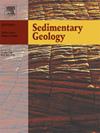Depositional process and sediment dispersal pattern of mass transport complex on a slope with numerous elliptical depressions, northwestern South China Sea
Abstract
A Quaternary mass transport complex (MTC), formed by debris flows on a slope with numerous elliptical depressions in the Qiongdongnan Basin, is identified using three-dimensional seismic data. 25 % (5.7 km3) of the total volume of the MTC was deposited on the Upper and Middle slopes, mainly owing to the elliptical depressions capturing the bypassed debris flows. The megascour with slot-like geometry on the base of the MTC trends north–north-east on the Upper and Middle slopes, implying debris flows flowed downslope toward the north–north–east. The steep slope is responsible for the bypassing of the main body of debris flows. Moreover, the steep slope probably accelerated the debris flows, and thus the debris flow plowed, eroded and incorporated the substrate sediments to form the megascour. As a result, 75 % (17.3 km3) of the total volume of the MTC occurs on the Lower slope, mainly consisting of the lobe-like accumulation zones 1 and 2. Trends of the pressure ridges in the lobe-like accumulation zone 1 suggest debris flows spread in an unconfined manner due to the relatively gentle Lower slope, until it reached the topographic barrier to the north. As a result of the blocking of the topographic high, only a portion of the debris flows continues to flow northeastward evidenced by the small-scale megascour with slot-like geometry on the base of the MTC resulting from the relatively steeper slope. It is clear that the topography of the pre-existing slope plays a significant role in the depositional process and dispersal of the MTC. Topography of the pre-existing slope mainly resulted from tectonic movements and sedimentary infilling processes. It was also complicated by the elliptical depressions that were formed by the normal-drag along the arcuate normal-faults, which are attributed to sediment load that favors the downward slip on the walls of the erosional troughs within the substrate of the MTC. The steep slope and high sedimentation rates probably are important triggers for the occurrence of the MTC. This study is helping to improve current knowledge of the interaction between debris flows and the topography of the pre-existing slope.

 求助内容:
求助内容: 应助结果提醒方式:
应助结果提醒方式:


